The NVIDIA GeForce GTX 780 Ti Review
by Ryan Smith on November 7, 2013 9:01 AM ESTHands On With NVIDIA's Shadowplay
Though it’s technically not part of the GeForce GTX 780 Ti launch, before diving into our typical collection of benchmarks we wanted to spend a bit of time looking at NVIDIA’s recently released Shadowplay utility.
Shadowplay was coincidentally enough first announced back at the launch of the GTX 780. Its designed purpose was to offer advanced game recording capabilities beyond what traditional tools like FRAPS could offer by leveraging NVIDIA image capture and video encode hardware. In doing so, Shadowplay would be able to offer similar capabilities with much less overhead, all the while also being able to utilize the NVENC hardware H.264 encoder to encode to space efficient H.264 rather than the bulky uncompressed formats traditional tools offer.
With Shadowplay and NVIDIA’s SHIELD streaming capabilities sharing so much of the underlying technology, the original plan was to launch Shadowplay in beta form shortly after SHIELD launched, however Shadowplay ended up being delayed, ultimately not getting its beta release until last week (October 28th). NVIDIA has never offered a full accounting for the delay, but one of the most significant reasons was because they were unsatisfied with their original video container choice, M2TS. M2TS containers, though industry standard and well suited for this use, have limited compatibility, with Windows Media Player in particular being a thorn in NVIDIA’s side. As such NVIDIA held back Shadowplay in order to convert it over to using MP4 containers, which have a very high compatibility rate at the cost of requiring some additional work on NVIDIA’s part.
In any case with the container issue resolved Shadowplay is finally out in beta, giving us our first chance to try out NVIDIA’s game recording utility. To that end while clearly still a beta and in need of further polishing and some feature refinements, at its most basic level we’ve come away impressed with Shadowplay, with NVIDIA having delivered on all of their earlier core promises for the utility
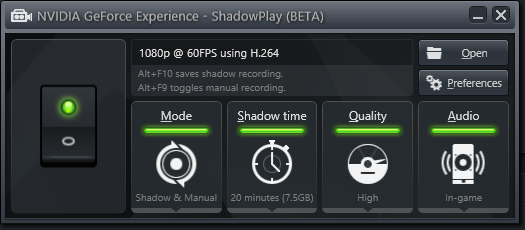
With regards to functionality, all of Shadowplay’s basic functionality is in. The utility offers two recording modes: a manual mode and a shadow mode, the former being self-explanatory while the latter being an always-active rolling buffer of up to 20 minutes that allows saving the buffer after the fact in a DVR-like fashion. Saving the shadow buffer causes the entirety of the buffer to be saved and a new buffer started, while manual mode can be started and stopped as desired.
| Shadowplay Average Bitrates | |||
| High Quality | 52Mbps | ||
| Medium Quality |
23Mbps
|
||
| Low Quality |
16Mbps
|
||
Next to being able to control the size of the shadow buffer, Shadowplay’s other piece of significant flexibility comes through the ability to set the quality (and therefore file size) of the recordings Shadowplay generates. Since Shadowplay uses lossy H.264 the recording bitrates will scale with the quality, with Shadowplay offering 3 quality levels: high (52Mbps), medium (23Mbps), and low (16Mbps). Choosing between the quality levels will depend on the quality needed and what the recording is intended for, due to the large difference in quality and size. High quality is as close as Shadowplay gets to transparent compression, and with its large file sizes is best suited for further processing/transcoding. Otherwise Medium and Low are low enough bitrates that they’re reasonably suitable for distribution as-is, however there is a distinct quality tradeoff in using these modes.
Moving on, at this moment while Shadowplay offers a range of quality settings for recording it only offers a single resolution and framerate: 1080p at 60fps. Neither the frame rate nor the resolution is currently adjustable, so whenever you record and despite the resolution you record from, it will be resized to 1920x1080 and recorded at 60fps. This unfortunately is an aspect-ratio unaware resize too, so even non-16:9 resolutions such as 1920x1200 or 2560x1600 will be resized to 1080p. Consequently at this time this is really the only weak point for Shadowplay; while the NVENC encoder undoubtedly presents some limitations, the inability to record at just a lower resolution or in an aspect ratio compliant manner is something we’d like to see NVIDIA expand upon in the final version of the utility.
Finally, let’s talk about performance. One of Shadowplay’s promises was that the overhead from recording would be very low – after all, it needs to be low enough to make always-on shadow mode viable – and this is another area where the product lives up to NVIDIA’s claims. To be sure there’s still some performance degradation from enabling Shadowplay, about 5% by our numbers, but this is small enough that it should be tolerable. Furthermore Shadowplay doesn’t require capping the framerate like FRAPS does, so it’s possible to use Shadowplay and still maintain framerates over 60fps. Though as to be expected, this will introduce some frame skipping in the captured video, since Shadowplay will have to skip some frames to keep within its framerate limitations.
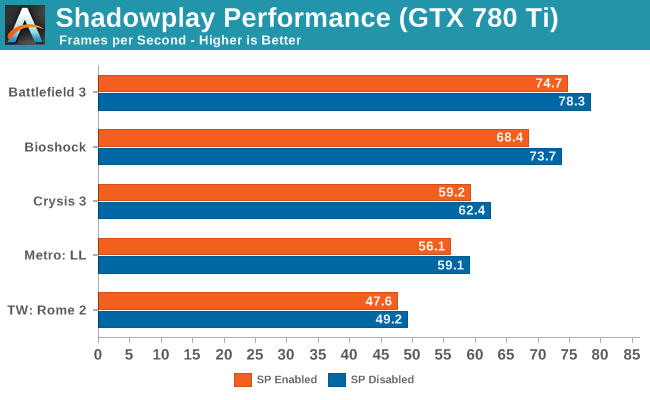
On a related note, we did some digging for a technical answer for why Shadowplay performs as well as it does, and found our answer in an excellent summary of Shadowplay by Alexey Nicolaychuk, the author of RivaTuner and its derivatives (MSI Afterburner and EVGA Precision). As it turns out, although the NVENC video encoder plays a part in that – compressing the resulting video and making the resulting stream much easier to send back to the host and store – that’s only part of the story. The rest of Shadowplay’s low overhead comes from the fact that NVIDIA also has specific hardware and API support for the fast capture of frames built into Kepler GPUs. This functionality was originally intended to facilitate GRID and game streaming, which can also be utilized for game recording (after all, what is game recording but game streaming to a file instead of another client?).
This functionality is exposed as Frame Buffer Capture (NVFBC) and Inband Frame Readback (NVIFR). NVFBC allows Shadowplay to pull finished frames straight out of the frame buffer directly at a low level, as opposed to having to traverse the graphics APIs at a high level. Meanwhile NVIFR does have operate at a slightly higher level to inject itself into the graphics API, but in doing so it gains the flexibility to capture images from render targets as opposed to just frame buffers. Based on what we’re seeing we believe that NVIDIA is using NVFBC for Shadowplay, which would be the lowest overhead option while also explaining why Shadowplay can only capture full screen games and not windowed mode games, as frame buffer capturing is only viable when a game has exclusive control over the frame buffer.
Wrapping things up, it’s clear that NVIDIA still has some polishing they can apply to Shadowplay, and while they aren’t talking about the final release this soon, as a point of reference it took about 4 months for NVIDIA’s SHIELD game streaming component to go from beta to a formal, finished release. In the interim however it’s already in a very usable state, and it should be worth keeping an eye on in the future to see what else NVIDIA does to further improve the utility.
The Test
The press drivers for the launch of the GTX 780 Ti are release 331.70, which other than formally adding support for the new card is otherwise identical to the standing 331.65 drivers.
Meanwhile on a housekeeping note, we want to quickly point out that we’ll be deviating a bit from our normal protocol and including the 290X results for both normal (quiet) and uber modes. Typically we’d only include results from the default mode in articles such as these, but since we need to cover SLI/Crossfire performance and since we didn’t have 290X CF quiet mode results for our initial 290X review, we’re throwing in both so that we can compare the GTX 780 Ti to the 290X CF without being inconsistent by suddenly switching to the lower performance quiet mode numbers. Though with that said, for the purposes of our evaluation we will be focusing almost entirely on the quiet mode numbers, given the vast difference in both performance and noise that comes from using it.
| CPU: | Intel Core i7-4960X @ 4.2GHz |
| Motherboard: | ASRock Fatal1ty X79 Professional |
| Power Supply: | Corsair AX1200i |
| Hard Disk: | Samsung SSD 840 EVO (750GB) |
| Memory: | G.Skill RipjawZ DDR3-1866 4 x 8GB (9-10-9-26) |
| Case: | NZXT Phantom 630 Windowed Edition |
| Monitor: | Asus PQ321 |
| Video Cards: |
AMD Radeon R9 290X AMD Radeon R9 290 XFX Radeon R9 280X Double Dissipation AMD Radeon HD 7990 AMD Radeon HD 7970 NVIDIA GeForce GTX Titan NVIDIA GeForce GTX 780 Ti NVIDIA GeForce GTX 780 NVIDIA GeForce GTX 770 |
| Video Drivers: |
NVIDIA Release 331.58 WHQL NVIDIA Release 331.70 Beta AMD Catalyst 13.11 Beta v1 AMD Catalyst 13.11 Beta v5 AMD Catalyst 13.11 Beta v8 |
| OS: | Windows 8.1 Pro |


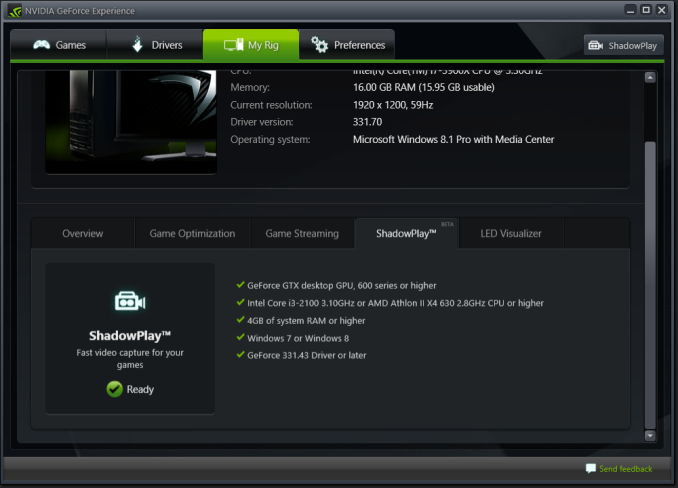
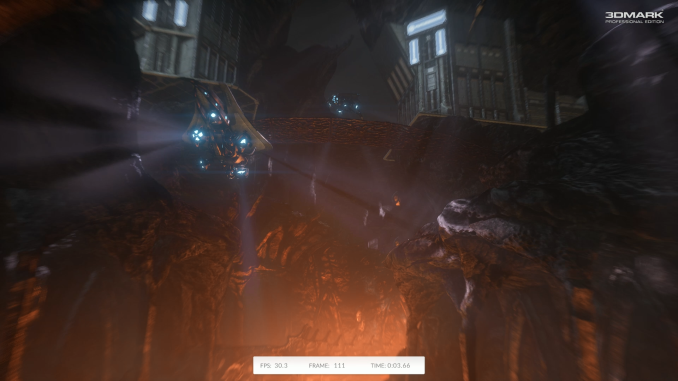

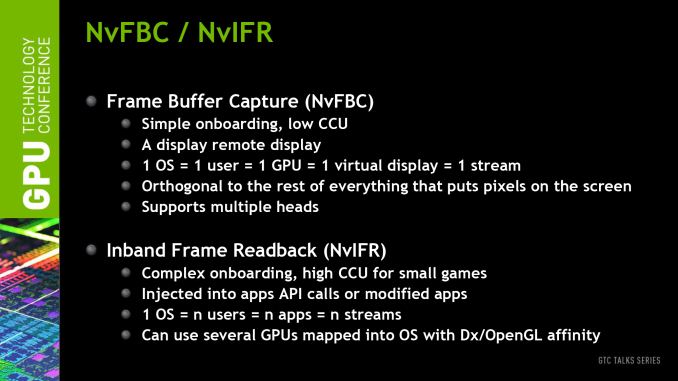














302 Comments
View All Comments
r13j13r13 - Friday, November 8, 2013 - link
a los fans de NVIDIA no se preocupen pronto sacaran la version de 1000 dolares con un 5% mas de rendimientotwtech - Friday, November 8, 2013 - link
An interesting comparison would be a 780 Ti vs. crossfired 290s. In the previous generation of cards, I wouldn't have considered that fair, as any type of SLI/crossfire setup was definitely inferior to any single-card setup in a variety of ways. But that's changed in this latest generation.I bought two 290X on launch day (I knew they would go out of stock by day 3, and not come back into general availability for something like 2 months), but the experience compared to the last time I'd tried CF a few years back was completely different. There are no bridges to worry about - you just plug in the two cards and go. CF doesn't have any sync polarity issues, and the driver support for CF & multi-monitor is actually pretty fleshed out. I didn't notice any stuttering or texture corruption as I had the previous time I'd given CF a try.
In fact the only reason I tried it now is because I have 3 2560x1600 monitors, and driving that is too much to ask out of a single card. The two 290X handle it easily though.
FuriousPop - Sunday, November 10, 2013 - link
what frames are you getting?i currently have 2x7970's in CF and was looking to upgrade to handle my same setup.
DMCalloway - Friday, November 8, 2013 - link
Wow !!! There sure are a lot of used 780's on Eb*y......meanwhile in a very luxurious board room in Santa Clara California ..... ' but sir.... do you really think they'll sell at that price point? '.....( while laughing ) ' of course they'll sell at that price point; our consumer research polls show that our customer base simply can't help themselves.'..... and throughout the world the rustling of wallets and swishing of credit cards could be heard as green team loyalist geared up to purchase their second almost $700 gtx 780 for 2013...... : )polaco - Friday, November 8, 2013 - link
This is what we are talking about:http://www.tomshardware.com/reviews/radeon-r9-290-...
when 290's get theirs non reference coolers NVidia 780 Ti will have to take it's bargains and go home definitley. AMD's 290 ans 290X series are full of hopes to hit even better performance numbers, however NVidia's 780Ti are at it's max.
EJS1980 - Friday, November 8, 2013 - link
" AMD's 290 ans 290X series are full of hopes to hit even better performance numbers, however NVidia's 780Ti are at it's max..."OC'ing the 780ti will give you around 15-20% more performance, or higher, so what the hell are you talking about? I realize you're in love with all things AMD, but if you can take your goggles off for a second, you'd realize the 780ti is actually a really great card (much like the 290(x), obviously).
I had NO IDEA how many AMD fanboys could be found mouth-breathing on the internet, at any given time. Which begs the question: if AMD has so many fanboys, why the f*ck are they doing so poorly in the discrete GPU market?
polaco - Saturday, November 9, 2013 - link
Yes I do prefer AMD due to it's fair price. However what I'm talking about is that with non reference cooler 290-290X will be able to run pretty cool and have decent overclocking potential too, as shown in tomshardware chart. Since they cost several bucks less than NVidia cards and at that point should be a pretty closed gap in performance (in fact they already are) then AMD cards will be at an extremely nice price/performance point. What do you mean by poorly in discrete GPU? Many APUs has been sold, APUs are replacing discrete GPUs, all PS4 and XBox One are like discrete GPUs. And I do have preference by AMD but mainly coz this reasons: they have always been trying to innovate, they have to compete with a giant as Intel and they bring price balance to the GPU / CPU market. That doen't mean I will buy them whatever they take to the market, I evaluate all options and buy what fits my needs better. In fact 780ti is a great card nobody says the opposite, just quite expensive from my point of view and I don't want to get into the "how much NVidia has been abusing buyers wallet during this months". I wonder if any NVidia fan that has acquired and 780 or Titan previouly to 290 entry to the market could recognize that...Owls - Saturday, November 9, 2013 - link
OCing a Ti is not guaranteed. Why do people parrot this info around like every card is going to peform the way you describe?EJS1980 - Saturday, November 9, 2013 - link
Again, what the hell are you people talking about???Even though results can very from card to card, EVERY 780ti can be overclocked to boost performance by a significant margin. These chips are the cream of the Kepler crop, and Nvidia is confident enough with their yields that a substantial OC is all but guaranteed with each card, as EVERY review so far has illustrated.
I personally feel this card is about a $100 overpriced, and as such, I will NOT be upgrading at this time. I also believe that even with the significant problems inherent to the new Hawaii chips, they are powerful cards at an EXCELLENT price point.
However, I'm not going to pretend that the 290(x) are faster than the 780ti, just because their priced better. So many of you guys keep pointing out that once after market solutions arrive, the 290(x) will take back the crown, and that simply isn't true. Performance will obviously improve, but only to levels comparable to a STOCK 780ti, and maybe not even that. That's where OC'ing comes in to play, for if we're going to compare the 290(x) OC'd with a better cooling solution, then the same must be applied to the 780ti too. I expect the 780ti to maintain its 5-15% performance advantage over the 290(x) after they've BOTH released their aftermarket solutions, so the question ultimately returns to whether or not the consumer finds that performance advantage to be worthy of the price differential. Just because you don't, or I don't, does NOT mean that anyone else won't too, or that there isn't even a advantage to begin with, which there undoubtedly will be...
Mondozai - Friday, December 13, 2013 - link
EJS1980, the mouth-breathing Nvidia fanboy, you're talking about a card(GTX 780 Ti) which with an aftermarket cooler could have an advantage as low as 5% for 200-250 dollars more in price. Only a Nvidia buttboy would think that's a good deal, you've been raped by them through their pricing for so long, you've come to even enjoy it.Most sane, non-buttboys will opt for the best price/performance ratio. Including for high-end cards. A 290 in CF with aftermarket coolers will crush everything. Even a 290X on an aftermarket cooler is going to do a lot better, especially as we transition to 4K within the next 1-2 years.
Stop being a buttboy for Nvidia.
(P.S. I'm currently using an Nvidia card, but I always get embarrassed when I see buttboys for a specific company like yourself).